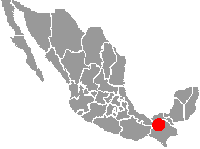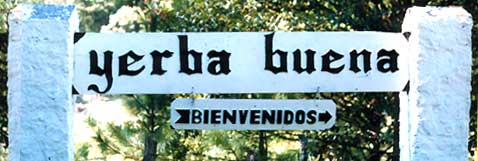

Coming up from the Gulf of Mexico side, I start in Villahermosa, capital city of the state of Tabasco. With a population of about l00,000, and important oil fields along the Gulf Coast just north of town, Villahermosa is bustling, surprisingly affluent and, even in January, usually too hot and wet.
Downtown I walk past a hardware store from which a man exits carrying three new machetes, their black blades wrapped in sheets of newspaper. Next door stands a bookstore with all the major Mexican magazines stacked unattended on tables out front, and then comes a pharmacy with its sweet odors of vitamin pills and linseed oil carrying onto the street. Especially at intersections, sidewalk kiosks sell yellow, blue and red plastic buckets, slices of crisp watermelon, hand-mirrors with pictures of the Virgin Mary on their backsides, and silver belt buckles... From a wooden cart built on bicycle wheels a ten-year-old boy sells spicy tacos wrapped in greasy napkins. Outside the bus station a six-year-old boy sells plastic bags filled with crisp, greasy slices of fried banana dowsed in Tabasco sauce. Here and there rise tall palm trees with smooth, whitewashed trunks. Fenced-in gardens next to people's homes overflow with vigorous, laughing kinds of dark greenness and sometimes bougainvillea and hibiscus blossoms explode in the morning air with raw, blood-red flower-color. And everywhere, everywhere, there are just too many kinds of hot, rushing, disorganized examples of humanity to describe...
The lowlands south of town used to be covered with real jungle -- tropical rainforest with tigers and monkeys. Even now, sometimes giant ceibas and towering strangler fig trees -- huge, ancient relicts they are -- rise gnarled and dark, surrounded by horizon-to-horizon plantations of glossy banana trees and immense, close-cropped pastures grazed placidly by white, hump-backed zebu cattle. Looking at the old tree-relicts, it's easy to imagine how for centuries these very organisms struggled upward toward sunlight filtering through the forest's canopy. Seeing how even still the old trees stretch skyward -- though today there's no longer need to stretch -- makes me feel sad.
Outside Pichucalco, foothills begin. The road gets narrower and starts to break up, and the bus's straining, unmuffled diesel-engine explosions ricochet off the slope, back into the bus's windows. Up and up we go, and though we're so packed that people cram the isle from the bus's very back, clear up front to beside the driver, and then down onto the stairwell leading into the bus... now we stop to let in two men wearing straw hats, one carrying a white, plastic bag holding an old red hen with a featherless neck.
Because of the curves, several of us get motion-sick and sit sweating with our foreheads cradled in our hands, or stand with our eyes closed, hanging desperately onto the baggage rack. It's too hot in here and the bus driver's marimba music is too, too loud! Babies wailing, chickens squawking, nauseating odors of cigarette smoke, cheap aftershave, overripe bananas, sour sweat coagulated in straw hats... but sometimes a fresh breeze comes through an open window and it's surprising how crisp and cool this window-air is becoming. Sometimes I glimpse through the window a profound greenness outside -- steep slopes patched with weedy cornfields. Right down below, white water gushes around enormous, round boulders while, above, ragged, slate-gray clouds cut off mountaintops.
Past Rayón people start closing windows because the air gushing in has become too cold. Outside, immense sheets of gray cloud-mist wash down from above, obliterating the view of the opposite slope, sometimes even enveloping the bus itself. Along the road, new kinds of plant appear -- Sweetgum trees with horizontal branches overgrown with ragged, gray and green gardens of bromeliads and ferns, and here and there rise fifteen-foot tall treeferns. People entering the bus now wear gum boots and heavy, dingy, ragged coats and shawls.
Just past Selva Negra (Black Jungle in English) the road more or less levels out. Now the world becomes drier and the air more crisp, and pines grow all around. Sunlight here is different from below -- bluer and somehow not so heavy. Here clouds are not leaden and sullen like those around Villahermosa, but rather they are white and behave like sailboats skating swiftly across a too-blue sky.
Extricating myself from the bus is an exercise in good- natured pushing and shoving. "Ay, perdóname, señora," I say again and again. Everybody laughs, for it's the only way to get unpacked. Everyone has to do it when his or her time comes, but it's especially funny seeing a gringo making the effort...
Having arrived at the lane leading down to Yerba Buena, now, at last, the bus pulls away, and it's time to simply lie in the weeds along the road and let the motion sickness pass. Cool wind filtering through tall pines and playful sunlight tickling the skin cause an October feeling, though it's January, not long after Christmas. Two men leading a burro loaded with firewood pass by, whispering to one another reproaches for the shameless North American lying stone-drunk in the grass.
But... during these last hours a certain thought has been brewing, and right now that thought is about to coalesce. Here it is:
This little clinic right below -- this place called Yerba Buena -- may offer much more than a mere history or story of how a certain Seventh-Day Adventist missionary-family from the U. S. came to Mexico and built a hospital among the isolated Tzotzil-speaking Indians. Those buildings, gardens, histories and potentials below must represent a certain statement about what can blossom forth when in a certain spiritual ambiance three very different cultures meld together -- the three cultures being native American, Latin American and U. S.
Moreover, somewhere down below must reside statements on how dignity can stand alongside poverty; of how suffering can mature into understanding; and of how mistrust can yield to love and respect. Surely these are messages appropriate for sending into that world there in the north, to you, my reader.
And I... Exactly how shall I fit into all this? I am a freelance writer invited by Yerba Buena's founders to spend a winter here writing a book, the proceeds of which will be used for buying medicine and hospital equipment for the local people's benefit; of that I am sure. But, what kind of book? Though each time I have visited Yerba Buena I've been profoundly affected by the settlement's spiritual and cultural environment, I am not a Seventh Day Adventist myself, nor do I even claim allegiance to any organized religious denomination or sect, Christian or otherwise. Certainly I am not prepared to fill a book stuffed with religious catch-phrases, dogmas or persuasions.
Feeling the sickness pass, but not yet being well enough to rise, I keep lying in the grass, letting the above thoughts mature. Yellow butterflies flit above me. Then gradually I begin to daydream -- or am I receiving a certain message? --that comes in the form of a vagrant memory from a few days back.
Then I was with my family in Kentucky. During Christmas vacation I'd found an old shoebox stuffed with unsorted snapshots accumulated by my mother during the course of many years. At first I'd felt that it was a shame that no one ever had taken the time to arrange chronologically the pictures into an album. However, as I drew out one randomly selected snapshot at a time, a rather magical thing happened:
Here, a snapshot from Thanksgiving, l967, with me home from college; here, the Red Maple tree blown down in front of the house during a storm two summers ago; here, a picture of my dog Spot when I was ten; here, my Grandfather Conrad, dead now these past twenty years; here, the tulips coming up along my mother's front porch just last spring...
This randomness, this honest, uncensored offering collected over a lifetime, showed me, hinted to me, demanded that I see... much more about my family's soul than could any slick album arranged systematically according to someone else's contrived system.
Yes: This book I propose to write about Yerba Buena shall be filled with pages gathered together like randomly collected snapshots over a lifetime tossed into a shoebox. Just maybe this approach will present, then, that part of Yerba Buena's story that goes beyond mere history, beyond mere documentation...
From the weeds along the road I rise and for a while stand blinking into the broad, green valley below. From my shirt pocket I remove a pen and a notebook. I step forward, and on the pages that follow are are the snapshots I find:
